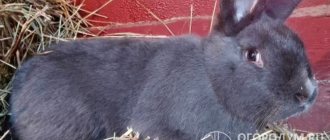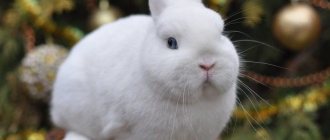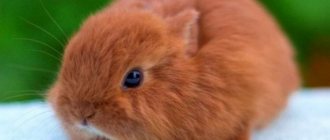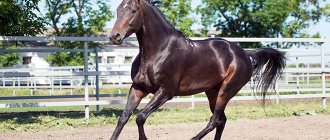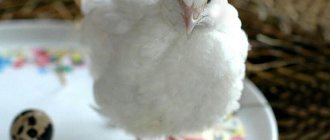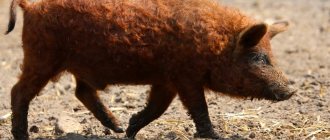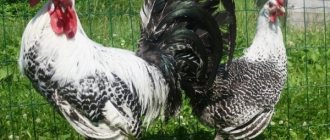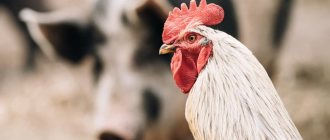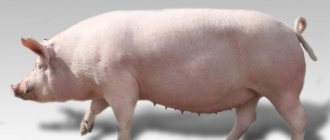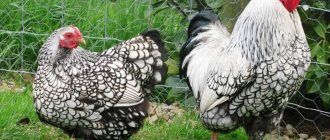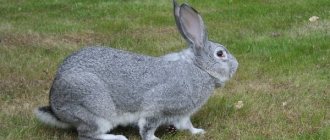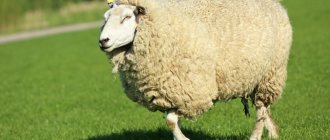White Giant rabbits are one of the most popular and widespread large breeds among rabbit breeders. They are distinguished by their ease of care, excellent meat-skin characteristics, high growth rate and fertility. The White Giant rabbit breed was the first and only one bred exclusively for the needs of Soviet fur production. And today the breed has not lost its popularity, because it is considered a “supplier” of nutritious meat and excellent snow-white fur.
History of origin
The White Giant rabbit is a “modern” variety, bred in the second half of the 20th century through the joint efforts of breeders from Germany and Belgium. They were left with the goal of breeding animals with high-quality fur skins for industrial needs.
The Belgian Giant breed, the largest in rabbit breeding in Belgium and Germany, is used in the “base” of the selection process. But it had two significant disadvantages - poor vitality and fertility indicators.
Breeding research was aimed at eliminating these disadvantages, the result of which was the White Giant - a breed of large rabbits with snow-white fur of the highest quality and excellent meat qualities.
Soviet breeders crossed the new breed with the Gray Giant, obtaining viable, hardy animals adapted to negative weather conditions, which gained popularity as the Albino rabbit.
External features.
Many people, having seen the White Giant, compare the color of its skin with the color of freshly fallen snow glistening in the sun, rabbits of this breed look so beautiful and impressive. The skin of a purebred animal does not contain even the slightest color inclusions; the required gene strictly monitors this. Many people immediately notice the bright red color of the eyes of the giant rabbit. This is also a consequence of albinism. After all, the eyeball, having no pigment, becomes transparent and we see the red blood capillaries located in it.
But the relationship with the Flanders provides large “dimensions” for our hare. The average weight of an adult rabbit is rarely less than 5 kg, and often more than that. The body size is also impressive. The length of the body is about 60 cm, the chest behind the shoulder blades has a girth of up to 40 cm, that is, it is well developed. In general, according to the established classification, the rabbit belongs to the leptosomal type (elongated body). The rabbit's ears are straight, slightly rounded. Their length reaches 15 cm (when measuring, the ruler must be placed between the ears, otherwise it will show all 20). The head itself is also quite large, but due to its elongation it is not overly heavy.
The paws are long, not very massive, but strong, set wide apart, which makes it easy to withstand the large weight of the animal. As a disadvantage - weak pubescence of the limbs and a tendency to calluses. Therefore, I recommend using solid floors for adult rabbits or at least making wooden inserts for resting. Many people practice slaughtering without waiting for the maximum possible weight and size of the giants, limiting themselves to approximately six months of fattening. This significantly reduces the risk of this disease.
Often female giants develop a dewlap that resembles a double chin. Inexperienced owners incorrectly believe that they are overfeeding the animal, and so that the rabbit does not become fat (then you will not be forced to go into mating with any gingerbread), they reduce the diet. In fact, these are the characteristics of this breed and the dewlap, on the contrary, indicates the good health of the rabbit.
Description of the White Giant breed
The specific features of White Giant rabbits are massive body parameters and snow-white color without foreign inclusions. The appearance of the animals has several characteristic features that distinguish them from other rabbit breeds.
Constitution
Rabbits have a large, massive build with well-developed muscles. Description of the White Giant breed:
- the parameters of the oblong, elongated body are 55-61 cm;
- the back is powerful and strong;
- expanded, well-developed sternum, the girth of which is 37-39 cm;
- the ears are wide, elongated and erect, up to 13-16 cm long (a quarter of the length of the body);
- the skull of males is somewhat larger than that of females;
- The paws are elongated, strong and muscular.
A characteristic feature of White Giant rabbits is the red tint of the eye pupils, although British rabbits also have a blue color.
Fur
The main characteristic feature of White Giants is perfectly white fur without yellowness, grayness or colored spots. Animals with such defects are culled.
Animal fur is dense, soft and smooth. The length of the fibers is 3.7-3.9 cm. Animal skins are used in industry both in their natural form and in dyed form.
Classes and vices of giants
Rabbits of the White Giant breed are distinguished by their characteristic features - ideally white and voluminous hair, body length up to 55-59 cm, sternum volume in the range of 37-39 cm and reddish eye color. Although blue eyes are found in European and British populations.
Based on body weight, animals are divided into classes:
- elite – up to 5700-5900 g;
- first – 5300-5400 g;
- second – 4800-4900
When breeding rabbits, animals with such defects as various degrees of clubfoot, narrowed sternum, and an intensively developed, powerful dewlap are subject to culling. Animals with pronounced symptoms of rickets - splayed legs, drooping back or hump - are also culled.
How to feed
The composition of the diet of these animals is practically no different from the menu of any other large breeds. The white and gray giant are rabbits that gain weight very quickly. Therefore, the feed intended for them must contain a sufficient amount of proteins. Oatmeal or crushed barley are usually used as concentrated grains on farms and in private households. It is not recommended to feed wheat to these animals. It can cause indigestion in rabbits.
In winter, they additionally provide hay, pre-prepared brooms (usually birch and willow), root vegetables, boiled potatoes and dried bread. In summer, grass (quinoa, nettle, dandelions, wheatgrass, plantain, wormwood, carrot tops, etc.), apples, beets and cabbage (in small quantities), and young tree branches are added to the crushed grain. Rabbits are especially good at eating carrots. It is very useful for their gastrointestinal tract, and it can be given in absolutely any quantity. The branches must be fed. Rabbits especially love birch, willow, elm, and elm.
It is very useful to give rabbits the so-called “vinaigrette”. To prepare it, they even use vegetables that these animals do not eat well in their raw form (pumpkin, zucchini, potatoes). Chopped root vegetables are mixed with chopped young grass, placed in a bucket and boiled. The water is drained, and the “vinaigrette” is fed to the rabbits in the morning.
Behavior of White Giant rabbits
The breed of giant rabbits has a calm and peaceful character. They never show anger or aggressiveness towards people or other animals. But if necessary, the animals will be able to protect themselves in the event of approaching danger.
A characteristic feature of Albino rabbits is the ability to fall into a kind of melancholic stupor. They can sit for a while without moving, without reacting to environmental factors and looking at one corner. This behavior is not considered a disease or vice, it is a specificity of a phlegmatic character.
Due to their friendly and balanced nature, these animals are often kept as family pets. The peacefulness and phlegmatic nature of the White Giant allows it to be kept in a private cottage or city apartment. The rabbit quickly becomes attached to its owner and becomes a loyal friend for the whole family.
How to keep rabbits in cages
Another advantage of this breed is that rabbits are equipped with warm skin, so there is no need to be afraid of hypothermia. So there is no need to insulate the cage, but, of course, drafts should not be allowed; no skin can save you from them, no matter how warm it is. If you choose a place for a cage, then you should not place it in the very sun; the best place is in the shade. You also need to know that such animals do not like cramped conditions, so you need to make a spacious cage.
As already mentioned, rabbits of this breed weigh a lot, which can lead to the formation of calluses on their paws. To prevent this, the floor of the cage must be well strengthened and equipped. A solid and smooth floor is ideal, but you can also limit yourself to wood. As for the material for the door, it should be mesh; if we are talking about winter, then you can hang the cages with burlap so that the rabbits are not blown by the cold wind. It is recommended to use tin bowls for drinking bowls; they do not break and are easy to clean.
When building a cage, you should pay attention to protection from rodents; for this, it should be lined with tin on the sides and bottom, then no rats will get to them. Rats are generally a scourge for rabbit breeders; not only do they devour all the rabbit’s food, but they are also carriers of dangerous infectious diseases. To prevent this, you can set up mousetraps and even traps.
Productivity
The main value when breeding White Giant rabbits is high-quality snow-white fur, which does not have any extraneous color inclusions. The fur of animals is extremely silky, thick and pleasant to the touch.
The meat characteristics of the giant are considered no less valuable. Given proper maintenance and a carefully balanced diet, rabbits show very rapid growth rates - by the age of 2 months their weight reaches 1350-1650 g.
At 4 months, the body weight of the animals reaches 2550-2850 g. It is this period that is accompanied by the most active weight gain. An adult Albino rabbit weighs up to 490-5400 g, occasionally larger individuals weighing up to 7000-7900 g are found. Males are 600-800 g heavier than females.
About rabbit nutrition
This breed of rabbits is unpretentious in food; they willingly eat ready-made food, but to save money, you can prepare the food yourself. These rabbits have an excellent appetite, but what do they love most:
You can prepare different vinaigrettes for rabbits:
Rabbits also love bread dipped in milk. If you feed such animals properly, their weight increases very quickly. Suffice it to say that a rabbit at the age of 4 months weighs on average 4 kilograms. If we are talking about summer, then it is better to release rabbits onto natural pastures, but not where there are poisonous plants. In order to protect long-eared pets from seasonal vitamin deficiency, they can be given vitamin supplements in the spring.
In order for the digestive tract to function normally, rabbits also need solid food; crackers are also suitable.
Breeding such rabbits can bring good income, since the giant quickly gains weight and reproduces well, but the rabbits should be taken care of, then the baby rabbit will grow into such an individual that its characteristics will delight the most demanding rabbit breeder. It is not difficult to breed a white rabbit, so those who are just starting their journey into rabbit breeding often choose this particular breed.
The animals' water should always be fresh, but if rabbits drink little, it means their diet completely provides them with liquid. Such rabbits are often kept at home as an ornamental animal, and their care must be appropriate. If you adhere to all the rules of courtship, then there will be no problems with them.
Mating of white giants
The best large breeds of rabbits: White Giant.
Source
Maintenance and care
One of the main advantages of White Giant rabbits is their unpretentiousness and undemanding maintenance. A novice rabbit breeder can provide comfortable care for furry animals.
White giants of Soviet populations are perfectly adapted to low air temperatures. They can easily endure winter frosts in the air. But in this case, you need to take care of a balanced, high-calorie diet for the animals.
Features of keeping giant rabbits:
- Animals can be kept in cages without additional insulation, as they have thick and warm fur.
- It is very important to choose the right place for the rabbit “home” - it should be away from direct sunlight and drafts. It is necessary to take into account the large physique of the animals and provide them with sufficient space.
- White Giant rabbits are prone to the frequent appearance of corns on their feet, so when decorating their “house” you should take care of a smooth, solid floor covering (possibly made of wood, but in no case mesh).
- The cage door is best made of mesh, and in winter it should be covered with thick burlap to protect the cage from cold and wind.
- Drinkers and feeders are installed in the cages. To maintain a sanitary and hygienic condition, it is best if they are made of easy-to-clean material.
- The litter tray should be removed every 2-3 days.
- Once every 4-5 weeks, the room with the rabbit cage is disinfected.
Water bowls and feeders in a rabbit hutch must be protected from rodents, since food is often attacked by rats and mice. For maximum protection, the bottom and sides of the cage should be lined with iron sheets - this will prevent rodents from getting inside. Mice and rats can not only damage rabbit food, but also infect animals with dangerous infectious diseases.
Before giving birth, a special queen cell is prepared for the females. This kind of “nest” is made 8-11 days before the appearance of the offspring. It should be placed on the side of the cage. The dimensions of the queen cell are 35 cm (width), 40 cm (height), 65 cm (length). The queen cell should have a removable lid, which makes caring for the rabbits easier.
About the contents of the queen cell
When setting up a cage, it is very important to pay attention to the queen cell, since the female will give birth to rabbits. As for the timing, the queen cell needs to be prepared a week before the birth, and certain rules should be followed:
- Place the queen cell on the side of the cage, standard sizes;
- the roof should be removable and placed on top, this will make it easier to examine the offspring without disturbing the family once again;
- the cage should be made into 2 floors, and the second floor should be especially protected.
Nutrition of the White Giant
Rabbits of the White Giant breed are large and strong animals, for which a balanced, high-calorie, protein diet is very important, ensuring the full growth and development of muscle mass of the animals.
Rabbit diet:
- cake, bran, feed for rabbits;
- crushed oat-barley mixtures;
- freshly cut or slightly dried grass - quinoa, plantain, wheatgrass, nettle, dandelions, wormwood);
- vegetable tops;
- hay;
- branches of young trees - willow, birch;
- vegetables - carrots, white cabbage, potatoes, zucchini, pumpkin.
When choosing grass for animals, you need to take into account that some varieties can cause serious poisoning. It is strictly forbidden to give dope, St. John's wort, celandine, henbane and spurge to rabbits.
Wet, freshly cut grass is slowly absorbed by the animal's digestive system and causes fermentation processes in the intestines, so it should be dried first. Also, beets should be given to rabbits with extreme caution - they often cause diarrhea in animals.
The favorite food for White Giant rabbits is raw, peeled and grated carrots. It saturates the animal’s body with all the necessary vitamins and minerals, ensuring full growth and development of the animals.
Rabbits eat other vegetables with less pleasure or refuse them. To improve the taste of vegetables, cut them into small pieces, mix with freshly cut herbs and boil for at least an hour. This will help “spark” the animals’ appetite for potatoes, zucchini and other vegetables.
Feeding and diet
The diet of rabbits of this breed is somewhat different from that of their relatives, primarily in the presence of a large amount of protein feed, which ensures the normal development of the individual with rapid weight gain.
The basis of the diet is roughage , which allows the sharp teeth of the animal to grind down. Rabbit food includes the following groups:
- Succulent feed - root crops, silage, melons. They feed animals in the autumn-winter period.
- Roughage containing fiber necessary for the normal development of animals.
- Green food - cabbage, cereals, legumes. It is also possible to use fallen fruit from fruit trees.
- Concentrates - feed, cake, bran. Such products have a low moisture content.
When choosing food for rabbits, you should take into account the requirement for a variety of animal nutrition. In general, representatives of the White Giant breed are unpretentious in their diet . In summer there are no problems at all with feeding pets. They will happily eat young shoots of trees, grass, and vegetables from their garden plot.
, hay and grain are prepared for albinos . Farmers who professionally breed rabbits prepare a special diet for their animals - a mixture of leftover food. Waste vegetables and fruits are boiled together with cereals, after which the liquid is drained, and the resulting salad is given to the rabbits for breakfast.
In addition, having a vegetable garden is a great help, from which the giants are given pumpkins, vegetable tops, cucumbers, carrots, and a variety of greens. The main requirement is high-quality products that do not have signs of rot and mold, otherwise pets risk poisoning and other health problems.
Sometimes you can treat your long-eared pets to some kind of treat; they especially love grapes. You can also amuse the White Giant with a piece of bread dipped in milk. The main food in winter is hay, prepared independently or purchased from other farmers.
In this case, you must pay attention to the appearance and color of the dry grass. Properly harvested hay has a green color and a pleasant, clean aroma, without the smell of mold or diaper rash. also pay attention to the composition of the feed , especially the content of clover and alfalfa - such grasses are not very beneficial for animals, so their quantity should be minimal.
From time to time, rabbits need to have fasting days , but this is not related to weight loss - the fact is that animals sometimes refuse roughage - this may indicate the consumption of too high-calorie foods. This condition also occurs when there is an excess of greenery. The hay diet involves using only dry grass, without any additions.
Profitability of rabbit breeding
The white giant is one of the breeds that are often found on Russian farms. It is very promising for breeding by both beginning rabbit breeders and large agricultural enterprises.
These animals produce high-quality, thick, snow-white fur, products from which are highly valued on the market. That is why the White Giant breed is considered one of the most promising for breeding for commercial profit.
The high profitability of the Albino breed is determined by rapid weight gain, excellent taste of meat combined with moderate feed conversion.
Rabbits German ram
A distinctive feature of some types of rabbits is their large head and muzzle, which in appearance resembles that of a lamb. Such animals have large drooping ears, which give their appearance a special meekness. They belong to decorative breeds and have different sizes.
The largest are German sheep, which are raised for meat, since the fur does not have a dense undercoat, and the skins of these animals are extremely low valued.
The body length of German sheep can reach 65-70 cm. The average weight of an adult animal is 6-7 kg, although with special care some individuals can gain up to 10 kg of live weight.
A huge advantage of German rams is their early maturity and multiple births. Females give birth to up to 7 babies in one litter, which grow very quickly, reaching slaughter weight by 4 months.
Due to drooping ears, sheep breed rabbits hear poorly and react little to external irritations. They are stress-resistant and have an excellent appetite. Keeping animals outdoors away from sunlight allows you to obtain a large amount of dietary meat in a short time with minimal expenditure of effort and money.
Reproduction and care of rabbits
Female rabbits of the White Giant breed are distinguished by good fertility. They are ready to breed throughout the year.
Peculiarities of breeding White Giant rabbits:
- Mating can be carried out after the males reach sexual maturity - approximately 5-6 months. After this, they become lazy, passive, and “acquaintance” with the opposite sex no longer arouses their interest.
- The female at the time of mating must have a body weight of at least 3500 g - this weight is typical for females 7-8 months of age.
- Mating is carried out twice with an interval of 6-7 days. If, after the first attempt, the female begins to bite the male, does not allow him to approach her, or fights him off, fertilization was successful.
There are up to 6-9 rabbits in one litter. The female exhibits excellent maternal qualities and high lactation rates, so the rabbits can be safely left with their mother. There is no cannibalism among this breed of rabbits.
Immediately after giving birth, you need to make sure that all the babies are near the mother. If the baby rabbit crawls to the side, it may freeze and die. Cubs are born weighing no more than 95-100 g and grow extremely quickly, gaining approximately 25-30 g per day.
Rabbits have a strong immune system, their viability reaches 98-99%. The cubs grow quickly and by 9-10 months they become sexually mature individuals with a body weight of about 5-5.2 kg.
The babies begin to leave the queen cell at the age of 16-20 days. When the rabbits reach 7-8 weeks, they can be separated from their mother, who is ready for subsequent mating.
Reviews from rabbit breeders
Oleg, 56 years old, Murino
Wonderful breed of rabbits! And very profitable from a breeding point of view. Excellent fertility of females, high survival rate of rabbits. As for the contents, special attention should be paid to the cages in which the animals will live. The fact is that white giants need more spacious cages than their counterparts. In any case, that's what I was told when I first started breeding this breed. And it is better to have a solid floor covering. Grid - absolutely not! After several months of living on such a floor, rabbits develop calluses on their paws, which are almost impossible to cure. And they cause a lot of inconvenience to animals.
Elena, 42 years old, Krasnodar
Most farmers breed white giants “for their skins” - they really are of high quality. However, I would also note the good meat characteristics of rabbits of this species. Females grow on average up to 5.5 kg, and males up to 6-7 kg. The yield of 3 kg of meat per carcass is a very decent result. Therefore, I can say with confidence that the breed is quite profitable for breeding.
Ekaterina, 55 years old, St. Petersburg
I have been keeping rabbits for several years now. I consider the white giant to be one of the most “grateful” breeds. The young animals grow and gain weight at a rapid pace, while feed consumption is moderate, as for giants. Even a novice farmer can cope with raising animals. Therefore, if you don’t know what type of rabbit to start with, opt for giant white ones.
Common diseases
The main problem that White Giant rabbits suffer from is painful calluses on their feet, which appear under the influence of large body weight. A sick animal becomes lethargic, apathetic, and tries to move as little as possible.
If left untreated, very painful, bleeding wounds and cracks appear at the site of the corns. The rabbit cannot move, his appetite completely disappears and bowel dysfunction develops. The severe stage of the disease is accompanied by damage to bones and tendons.
What is the mother house for?
If the owner independently makes cages for rabbits, then one must not forget about the mother house. As a rule, it is made removable and installed 10 days before the expected date of appearance of the young animals. It is important to follow some rules when installing the much-needed “room”:
- installation is carried out from the side, usually the design has the following parameters 35x60x30 (length, width, height);
- the removable roof allows you to easily inspect the nest;
- if the cage is two-story, then when the queen cell is located on the second tier, the cage is separately insulated.
White giant rabbits
Advantages and disadvantages of the breed
White Giant rabbits are very popular among Russian and European rabbit breeders. This variety has a number of advantages over other breeds:
- excellent density and high quality of snow-white fur;
- large body weight, providing good meat yield and large skin sizes;
- high nutritional and taste properties of meat;
- rapid rate of weight gain;
- calm, balanced character;
- good fertility and early maturity;
- favorable conversion of feed into live weight;
- unpretentiousness in nutrition.
But this breed also has several disadvantages that the breeder needs to take into account. Due to their large body weight, these furry animals are prone to pododermatitis - the appearance of corns on their paws. They cause the rabbit severe pain and discomfort.
Female White Giants often develop mastitis, so when breeding animals of this breed, it is important to carefully monitor their health.
The white giant is one of the most common breeds of rabbits among rabbit breeders. It has gained wide popularity due to its excellent meat qualities, calm, balanced character and ease of care. With proper care, these animals demonstrate excellent indicators of fertility, early maturity and meatiness.
Treatment of advanced pododermatitis
If the disease develops seriously, the following measures should be taken:
- Diversify the animal's diet.
- Clean the cage thoroughly.
- It is advisable to let a sick animal run on the grass several times a day.
Well, of course, you should contact your veterinarian. Pododermatitis is usually treated with powders or ointments. Such, for example, as “Vagotil”, “Terramycil”, “Trauma-gel”. Usually the course of treatment lasts about a month. Levomekol ointment also gives very good results. It not only heals wounds on the paws, but also draws pus out of them. If even this remedy does not help, you can use the drug Triderm.
Areas of paws treated with ointment must be bandaged. Otherwise, the rabbit will lick the product, thereby harming its digestion. Rubber bandages cannot be used. They interfere with blood circulation in the paws.
German giant or Risen
Rabbits of the Risen breed attract the attention of breeders due to their large size, high-quality fur and dietary meat. German giants of massive build are characterized by clumsiness and clumsiness, so it is advisable to keep them in large cages
The character of German giants is kind and flexible, non-conflicting. They are not difficult to train. The muscles are well developed. The body is massive, proportional to the head. The back is wide, the chest is powerful. The muzzle of females is gracefully elongated, while that of males is round in shape with puffy cheeks. The eyes are brown.
The length of erect ears reaches twenty centimeters. The weight of an adult Risen is approximately ten kilograms, but can even reach up to fifteen. The coat is short and hard, its length reaches five centimeters. The color is beautiful - from blue to dark gray.
Expert opinion Dobryshev Sergey Anatolyevich Professional rabbit breeder and hare breeder with 30 years of experience
IMPORTANT!!! Rizens are more likely to belong to the meat direction. Their meat is highly prized
However, beautiful animal fur is also widely sold.
Vienna blue
This breed is distinguished primarily by its external beauty. The Vienna Blue Giant breed was developed by the Austrian breeder Johann Konstantin Schultz. He achieved this result for several years. In our country, the breed was acclimatized to local weather conditions, increased in size and improved the taste of the meat.
The body of Viennese blue rabbits is large and muscular, and the back and chest are wide. The weight of an adult is approximately five kilograms. Legs straight and strong. The head and ears are of medium size. Beautiful noble fur has no inclusions or spots, the density is the same throughout the body. The color of the eyes matches the coat - bluish-gray.
Their character is calm, non-aggressive, and friendly. They are distinguished by both curiosity and timidity. They are easy to train and get used to people quickly, which makes it possible to use them as pets.
When breeding Vienna Blues, the main focus is the use of their skins due to their pleasantly colored fur. This species has the most beautiful fur among all meat breeds. Viennese blue rabbits can live and breed throughout almost the entire territory of Russia.
Ram
This name was given to the giant rabbits of this breed due to their drooping ears, which is not typical for other representatives of these animals. This feature was fixed by breeders at the genetic level.
Fold-eared rams have an unusually shaped head, and a pronounced hump on the nose, which, in fact, gives them an external resemblance to rams. The popularity of this breed in Russia is constantly increasing.
The length of the characteristic drooping ears of rams can reach more than half a meter. Sometimes you have to resort to unusual measures and pinch them using special clamps. Distinctive features also include a wide forehead and thick, rounded cheeks. The original appearance is complemented by large expressive eyes. It should be borne in mind that this structure of the ears makes rams less susceptible to various sounds.
The muscle mass of rams can be called significant; physically they are well developed. The average weight is up to five kilograms, but can reach ten. The coat is soft, thick and long. The most common colors are black, blue, red and brick.
The character of rams is peaceful and friendly. They are easy to train and can be used as pets.
Butterfly
This breed is notable for its unusual coloring, which gives the rabbits such a unique name. The breed was developed by the British back in the nineteenth century. Over time, the characteristics of rabbits were greatly improved.
Butterflies can be bred to obtain both dietary meat and valuable fur. These animals are not particularly whimsical; their care is ordinary.
Expert opinion Dobryshev Sergey Anatolyevich Professional rabbit breeder and hare breeder with 30 years of experience
There are spots on the muzzle of rabbits and on the sides, located symmetrically, and on the back there is a stripe, which together creates the impression of a butterfly with open wings. Dark coloring is also present on the erect ears.
Distinctive characteristics of the breeds
Belonging to different subspecies allows animals to be divided according to external characteristics (size, color, thickness of fur), as well as their intended purpose.
- White giant. It has snow-white fur, red eyes, thick hair, a body length of 55 - 65 cm. The weight of the rabbit is 5.3 kg. Used to obtain easily dyed fur and crossbreed with giants of other breeds. It is peaceful and develops quickly.
- Gray giant. It is distinguished by its gray color (the quality is unstable, sometimes white or black animals are found), long body (up to 65 cm), weighing 4.1 - 6.5 kg. It is resistant to cold and has a strong immune system (the first representative of this breed is the Russian giant rabbit). Gray giants are unpretentious to food and cleanliness, but their meat yield is relatively small. Suitable for home breeding.
- Butterfly. An animal with a characteristic spotted color (the symmetrical arrangement of these spots on the back and sides is noteworthy), a small body (up to 60 cm), and a weight of up to 4.5 kg. It is famous for its fertility and growth rate, but is not widespread.
- Belgian giant (Flanders). A very impressive creature weighing up to 12 kg, with an elongated body and ears up to 18 cm long (with spherical tips). It is characterized by late puberty, fertility, demanding food and increased appetite. The progenitor of most other breeds, it is used for meat.
- German giant (risen). It grows to a weight of 12 kg and a length of 0.7 m. This breed of rabbit is the second most popular in the world. Thanks to its golden, blue or white color, it is in demand at exhibitions. Prolific and disease-resistant, rizens do not tolerate dirt. There are frequent cases when females refuse to care for numerous offspring.
- Blue giant (Viennese). It has a dense gray undercoat and a weight of 3 - 5 kg. It is characterized by accelerated growth, increased fertility and tasty meat.
- Ram. The specific name is due to the fact that representatives of the breed have an unusual skull shape, similar to that of a lamb. The maximum weight of such giants reaches 5 - 8 kg, they have a good-natured and calm character, and are distinguished by thick soft fur. Due to the specific shape of their ears, sheep do not hear very well. However, this makes them less timid.
Giant rabbits are divided into different breeds with specific characteristics
All of the above breeds are well known to breeders and farmers. However, some species of giants appeared and gained popularity relatively recently, so they constitute a separate category of eared animals.
Breed characteristics
The main characteristic is the snow-white color of the fur. The shine of their coat makes these rabbits showy and attractive. The nature of the animals is quite calm; external stimuli do not have a strong influence on them. Their natural affection and playfulness allows them to be kept as pets.
Breed characteristics
Breed standard
In rabbit breeding, minimum requirements are formulated that apply to the external parameters of the animal, its productivity and pedigree. This is called the breed standard. Large deviations from the established requirements are not allowed.
Externally, the rabbit of this breed looks like a stocky animal with a long body. The length of the hairs is about 4 cm, the fur itself is dense. According to the classification adopted in rabbit breeding in Russia, animals of this breed are classified as leptosomal type.
An elongated head, paws and body are the distinctive features of the breed
The head of rabbits is quite large. But against the backdrop of the long body, this feature gives the head elegance. The muzzle is extended forward. The animal's ears are always in a standing position. Their length, when measured from the inside, reaches 15 cm, and from the outside - 20 cm. The width of the ears is greatest in the middle part. Like other albinos, the white giant has no pigmentation, which is why all representatives of this breed have red eyes.
The body of the animals is quite long, up to 60 cm. The chest is developed, but its width is small - the girth ranges from 37 to 40 cm. The back of males and females is wide and straight. The upper and lower lines of the body form clear parallel lines without creases.
An elongated head, paws and body are the distinctive features of the breed
Representatives of the breed have very strong, widely spaced paws. Another feature is that the feet are almost not covered with hair (when compared with other breeds of rabbits), which is why calluses can form in animals kept in cages with mesh floors.
Inadmissible vices
Livestock breeders have established not only standards, but also certain defects that indicate a violation of the breed. These include:
- sagging, hunchbacked back as a result of rickets;
- narrow chest (such specimens are not used for breeding);
- large size dewlap;
- clubfoot;
- close location of the hock joints;
- unnaturally small number and condition of nipples in females.
A large dewlap is a deviation
It is important to pay attention to such defects for those farms that plan to breed rabbits for sale.
Technology and growing methods
Representatives of special farms are engaged in breeding eared animals; their number in Russia is only growing every year.
Raising rodents brings great benefits: meat rabbits are characterized by increased early maturity, and their tender light meat is in high demand among consumers. Farm breeding resembles a conveyor belt, but this approach allows you to conduct business as profitably as possible.
Raising rabbits for meat on a farm requires special cages, but this has already been mentioned earlier. Modern models have built-in heating, lighting, and automatic cleaning and feeding systems.
Animals in such conditions have a greater chance of a healthy life and proper development, so it is better to house tender young animals in purchased ones.
It is possible to raise an entire rabbit population outside of farm conditions . To raise rabbits at home, special cages with limited space are purchased.
When fattening for meat, rabbits should not be given a lot of space to move. The cages should be placed in a clean room with low humidity and average lighting.
At home, the intricacies of keeping them are slightly different: you need to manually give the animals nutritious food and purified water, monitor the intake of vitamins in their bodies, and vaccinate the long-eared ones against myxomatosis and other common rabbit diseases.
To receive proper control from a veterinarian, arrange for a specialist to come to your home. Now you know how to breed (raise) rabbits for meat.
Obedient and friendly giant
Their adorable nature and amazing intelligence make these rabbits a great pet. In fact, many people say that continental giants act more like dogs than rabbits.
These animals are easy to train and will play if given the appropriate stimulation. They can also learn to use the litter box and come when called quite easily...
In general, continental rabbits do not like to be transported, especially not more or less
Additionally, in order for these rabbits to be able to relax around people, it is important to handle them carefully from the time they are small
It is important to note that any rash or irresponsible handling may result in injury to the Continental Giants' spine and injury to the handler...
New breeds
New breeds include those that were developed in the 20th and early 21st centuries. This list includes several giants.
- Silver. Bred in the mid-20th century, formed by breeders of the Tula region from the imported Champagne breed. Gives more meat and wool compared to the source.
- Golden. The appearance of the breed is the result of a spontaneous mutation of gray giants. Valued for its golden fur and yellowish undercoat, it produces good offspring and is distinguished by a pronounced maternal instinct.
- Russian ermine. It takes root without problems in many climatic conditions. It is a source of dietary meat and skins.
- New Zealand red. It has hard and thick reddish fur and a short (0.5 m) fleshy body, gives large litters.
- Alaska. Distinctive characteristics: glossy black, with a bluish undercoat, color. The offspring are few in number, but not picky about their habitat.
- Vienna black. The body is strong and powerful. The head is unusually large. It is especially valued for its richly colored fur with a slight metallic sheen.
New breeds were developed in the 20-21st century
Diseases of giant rabbits and methods of treating them
Most ailments of giant rabbits can be cured if detected in a timely manner. The most common ones are listed in this list:
- Worms. They can be found in feces. When sick, the animal loses weight, suffers from diarrhea and does not eat. To rid him of helminths, you need to regularly disinfect his cage, give him naphthamon and homeopathic medicines.
- Ringworm. Small pink spaces appear on the fur, which peel off. To cure ringworm, you should lubricate the lesions with a weak solution of iodine or salicylic alcohol. After the procedure, you need to smear the affected areas with heated fish oil.
- Fleas. They can be found in the ears and on the body. You need to bathe the animal with a special shampoo.
- Rhinitis. This disease manifests itself in the same way as in humans. The nose becomes red, mucus flows out of it, and the animal sneezes. To prevent pneumonia from becoming a consequence of a runny nose, you need to drip a one percent solution of furatsilin into the animal’s nose for fourteen days (nine drops in each nostril).
- Stomatitis. With this disease, the rabbit cannot eat due to pain in the mouth, he is lethargic, and ulcers appear on his tongue. The method of treatment is to treat the entire oral cavity with a two percent solution of copper sulfate.
- Pasteurellosis. Signs of the disease include conjunctivitis, white purulent discharge, loss of appetite. The treatment regimen must be agreed with a veterinarian. Most likely he will recommend injections.
- Hemorrhagic disease. Bleeding from the anus, nose, mouth and ears, lethargy, diarrhea, loss of appetite are its symptoms. Ninety percent of the individuals die after it, and the rest must be destroyed.
- Gastrointestinal diseases. Feces with mucus, bloating, diarrhea, a depressed state - all of this can characterize a disease of the gastrointestinal tract. The treatment method is a daily fasting diet. After it, you need to feed the rabbit soft, freshly prepared food. If a rabbit has diarrhea, he should be given a decoction of oak bark to drink (one small spoon). For bloating, you will need a small spoon of a ten percent ichthyol solution.
